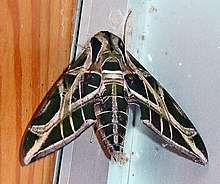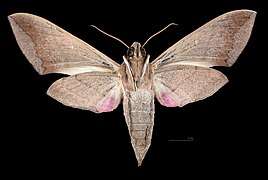Eumorpha vitis
Eumorpha vitis, known as the vine sphinx, is a moth of the family Sphingidae.
| Vine sphinx | |
|---|---|
 | |
| Scientific classification | |
| Kingdom: | Animalia |
| Phylum: | Arthropoda |
| Class: | Insecta |
| Order: | Lepidoptera |
| Family: | Sphingidae |
| Genus: | Eumorpha |
| Species: | E. vitis |
| Binomial name | |
| Eumorpha vitis | |
| Synonyms | |
| |
Distribution
It lives from Argentina north through Central America, the West Indies, and Mexico to southern Arizona, Texas, Mississippi, and Florida. Strays north to Nebraska.[2]
Description
The wingspan is 85–105 mm. It is similar to Eumorpha fasciatus fasciatus but distinguishable by the lack of a pink marginal band on the hindwing upperside and the single straight line on the forewing upperside.
 Male dorsal
Male dorsal Male ventral
Male ventral Female dorsal
Female dorsal Female ventral
Female ventral
Biology
Adults are on wing from April to May and again from July to October in Florida, from July to September in one generation in the northern part of the range and year-round in the tropics. They feed on the nectar of various flowers, including Vinca rosea.
The larvae feed on Vitis species (including Vitis vinifera), Cissus species (including Cissus incisa, Cissus pseudosicyoides, Cissus rhombifolia, Cissus sicycoides and Cissus verticillata), Ludwigia decurrens, Ludwigia erecta, Magnolia virginiana and Parthenocissus species. There are green, yellow and purple colour morphs. Pupation takes place in burrows.
Subspecies
- Eumorpha vitis vitis (Argentina, Bolivia, Brazil, Colombia, Ecuador, Peru, French Guiana, Guyana, Paraguay, Suriname, Uruguay, Venezuela, Mexico, Belize, Guatemala, Honduras, Nicaragua, Costa Rica, Panama, the Caribbean, southern United States)
- Eumorpha vitis fuscatus - (Rothschild & Jordan, 1906) (St. Lucia, Guadeloupe and Martinique)
- Eumorpha vitis hesperidum - (Kirby, 1880) (Jamaica)
 Eumorpha vitis fuscatus
Eumorpha vitis fuscatus
Male dorsal Eumorpha vitis fuscatus
Eumorpha vitis fuscatus
Male ventral Eumorpha vitis fuscatus
Eumorpha vitis fuscatus
Female dorsal Eumorpha vitis fuscatus
Eumorpha vitis fuscatus
Female ventral
References
- "CATE Creating a Taxonomic eScience - Sphingidae". Cate-sphingidae.org. Archived from the original on 2012-11-13. Retrieved 2011-10-26.
- "Silkmoths". Silkmoths.bizland.com. Archived from the original on 2015-05-14. Retrieved 2011-10-26.